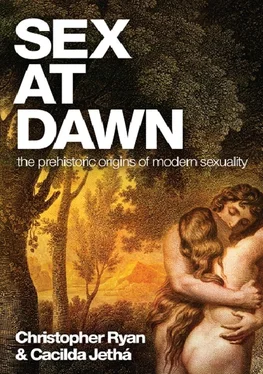Christopher Ryan - Sex at Dawn
Здесь есть возможность читать онлайн «Christopher Ryan - Sex at Dawn» весь текст электронной книги совершенно бесплатно (целиком полную версию без сокращений). В некоторых случаях можно слушать аудио, скачать через торрент в формате fb2 и присутствует краткое содержание. Жанр: Прочая научная литература, на английском языке. Описание произведения, (предисловие) а так же отзывы посетителей доступны на портале библиотеки ЛибКат.
- Название:Sex at Dawn
- Автор:
- Жанр:
- Год:неизвестен
- ISBN:нет данных
- Рейтинг книги:4 / 5. Голосов: 1
-
Избранное:Добавить в избранное
- Отзывы:
-
Ваша оценка:
- 80
- 1
- 2
- 3
- 4
- 5
Sex at Dawn: краткое содержание, описание и аннотация
Предлагаем к чтению аннотацию, описание, краткое содержание или предисловие (зависит от того, что написал сам автор книги «Sex at Dawn»). Если вы не нашли необходимую информацию о книге — напишите в комментариях, мы постараемся отыскать её.
Sex at Dawn — читать онлайн бесплатно полную книгу (весь текст) целиком
Ниже представлен текст книги, разбитый по страницам. Система сохранения места последней прочитанной страницы, позволяет с удобством читать онлайн бесплатно книгу «Sex at Dawn», без необходимости каждый раз заново искать на чём Вы остановились. Поставьте закладку, и сможете в любой момент перейти на страницу, на которой закончили чтение.
Интервал:
Закладка:
It’s important to keep in mind that when viewed against the full scale of our species’ existence, ten thousand years is but a brief moment. Even if we ignore the roughly two million years since the emergence of our Homo lineage, in which our direct ancestors lived in small foraging social groups, anatomically modern humans are estimated to have existed as long as 200,000 years. With the earliest evidence of agriculture dating to about 8000 BCE, the amount of time our species has spent living in settled agricultural societies represents just 5 percent of our collective experience, at most. As recently as a few hundred years ago, most of the planet was still occupied by foragers.
So in order to trace the deepest roots of human sexuality, it’s vital to look beneath the thin crust of recent human history. Until agriculture, human beings evolved in societies organized around an insistence on sharing just about everything. But all this sharing doesn’t make anyone a noble savage. These pre-agricultural societies were no nobler than you are when you pay your taxes or insurance premiums. Universal, culturally imposed sharing was simply the most effective way for our highly social species to minimize risk. Sharing and self-interest, as we shall see, are not mutually exclusive. Indeed, what many anthropologists call fierce egalitarianism was the predominant pattern of social organization around the world for many millennia before the advent of agriculture.
But human societies changed in radical ways once they started farming and raising domesticated animals. They organized themselves around hierarchical political structures, private property, densely populated settlements, a radical shift in the status of women, and other social configurations that together represent an enigmatic disaster for our species: human population growth mushroomed as quality of life plummeted. The shift to agriculture, wrote author Jared Diamond, is a “catastrophe from which we have never recovered.” 6
Several types of evidence suggest our pre-agricultural (prehistoric) ancestors lived in groups where most mature individuals would have had several ongoing sexual relationships at any given time. Though often casual, these relationships were not random or meaningless. Quite the opposite: they reinforced crucial social ties holding these highly interdependent communities together. 7
We’ve found overwhelming evidence of a decidedly casual, friendly prehistory of human sexuality echoed in our own bodies, in the habits of remaining societies still lingering in relative isolation, and in some surprising corners of contemporary Western culture. We’ll show how our bedroom behavior, porn preferences, fantasies, dreams, and sexual responses all support this reconfigured understanding of our sexual origins. Questions you’ll find answered in the following pages include:
• Why is long-term sexual fidelity so difficult for so many couples?
• Why does sexual passion often fade, even as love deepens?
• Why are women potentially multi-orgasmic, while men all too often reach orgasm frustratingly quickly and then lose interest?
• Is sexual jealousy an unavoidable, uncontrollable part of human nature?
• Why are human testicles so much larger than those of gorillas but smaller than those of chimps?
• Can sexual frustration make us sick? How did a lack of orgasms cause one of the most common diseases in history, and how was it treated?
In a nutshell, here’s the story we tell in the following pages: A few million years ago, our ancient ancestors (Homo erectus) shifted from a gorilla-like mating system where an alpha male fought to win and maintain a harem of females to one in which most males had sexual access to females. Few, if any experts dispute the fossil evidence for this shift.
But we part company from those who support the standard narrative when we look at what this shift signifies. The standard narrative holds that this is when long-term pair bonding began in our species: if each male could have only one female mate at a time, most males would end up with a girl to call their own. Indeed, where there is debate about the nature of innate human sexuality, the only two acceptable options appear to be that humans evolved to be either monogamous (M-F) or polygynous (M-FFF+)—with the conclusion normally being that women generally prefer the former configuration while most men would opt for the latter.
But what about multiple mating, where most males and females have more than one concurrent sexual relationship? Why—apart from moral disgust—is prehistoric promiscuity not even considered, when nearly every relevant source of evidence points in that direction?
After all, we know that the foraging societies in which human beings evolved were small-scale, highly egalitarian groups who shared almost everything. There is a remarkable consistency to how immediate return foragers live—wherever
*
they are. The !Kung San of Botswana have a great deal in common with Aboriginal people living in outback Australia and tribes in remote pockets of the Amazon rainforest. Anthropologists have demonstrated time and again that immediate-return hunter-gatherer societies are nearly universal in their fierce egalitarianism. Sharing is not just encouraged; it’s mandatory. Hoarding or hiding food, for example, is considered deeply shameful, almost unforgivable behavior in these societies.
Foragers divide and distribute meat equitably, breastfeed one another’s babies, have little or no privacy from one another, and depend upon each other for survival. As much as our social world revolves around notions of private property and individual responsibility, theirs spins in the opposite direction, toward group welfare, group identity, profound interrelation, and mutual dependence.
Though this may sound like naive New Age idealism, whining over the lost Age of Aquarius, or a celebration of
prehistoric communism, not one of these features of pre-agricultural societies is disputed by serious scholars. The overwhelming consensus is that egalitarian social organization is the de-facto system for foraging societies in all environments. In fact, no other system could work for foraging societies. Compulsory sharing is simply the best way to distribute risk to everyone’s benefit: participation
mandatory. Pragmatic? Yes. Noble? Hardly.
We believe this sharing behavior extended to sex as well. A great deal of research from primatology, anthropology, anatomy, and psychology points to the same fundamental conclusion: human beings and our hominid ancestors have spent almost all of the past few million years or so in small, intimate bands in which most adults had several sexual relationships at any given time. This approach to sexuality probably persisted until the rise of agriculture and private property no more than ten thousand years ago. In addition to voluminous scientific evidence, many explorers, missionaries, and anthropologists support this view, having penned accounts rich with tales of orgiastic rituals, unflinching mate sharing, and an open sexuality unencumbered by guilt or shame.
If you spend time with the primates closest to human beings, you’ll see female chimps having intercourse dozens of times per day, with most or all of the willing males, and rampant bonobo group sex that leaves everyone relaxed and maintains intricate social networks. Explore contemporary human beings’ lust for particular kinds of pornography or our notorious difficulties with long-term sexual monogamy and you’ll soon stumble over relics of our hypersexual ancestors.
Our bodies echo the same story. The human male has testicles far larger than any monogamous primate would ever need, hanging vulnerably outside the body where cooler temperatures help preserve stand-by sperm cells for multiple ejaculations. He also sports the longest, thickest penis found on any primate on the planet, as well as an embarrassing tendency to reach orgasm too quickly. Women’s pendulous breasts (utterly unnecessary for breastfeeding children), impossible-to-ignore cries of delight female copulatory vocalization to the clipboard-carrying crowd), and capacity for orgasm after orgasm all support this vision of prehistoric promiscuity. Each of these points is a major snag in the standard narrative.
Читать дальшеИнтервал:
Закладка:
Похожие книги на «Sex at Dawn»
Представляем Вашему вниманию похожие книги на «Sex at Dawn» списком для выбора. Мы отобрали схожую по названию и смыслу литературу в надежде предоставить читателям больше вариантов отыскать новые, интересные, ещё непрочитанные произведения.
Обсуждение, отзывы о книге «Sex at Dawn» и просто собственные мнения читателей. Оставьте ваши комментарии, напишите, что Вы думаете о произведении, его смысле или главных героях. Укажите что конкретно понравилось, а что нет, и почему Вы так считаете.












